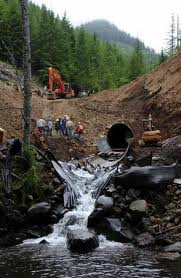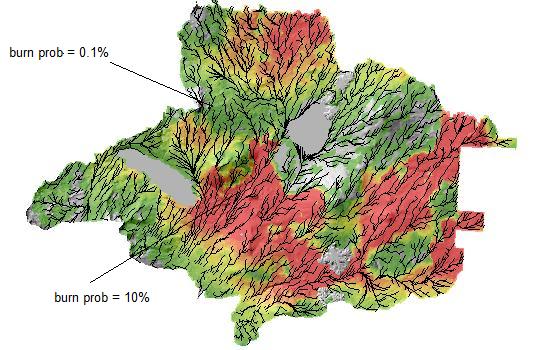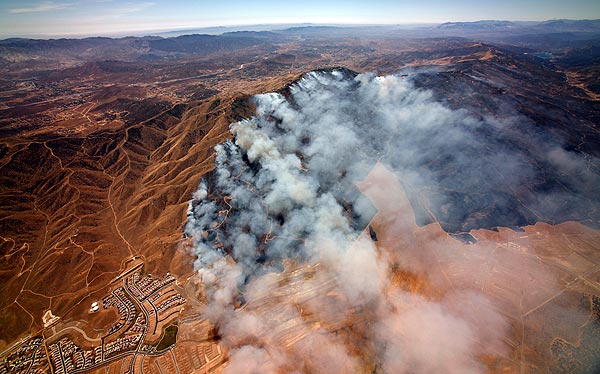
Note by Sharon. This is the first of two guest posts by Derek. The second focuses on Montana.
There’s an exciting new change blowing across the West these days. It bodes well for the future of forestry. “Changing public values” was a phrase the Forest Service often used to justify reducing timber harvests. I’ve read a version of the phrase in every USFS revised forest plan put out since the 90’s. Well, public values are changing back again. Across the West, the public now wants more logging.
The Mountain Pine Beetle(MPB) epidemic that’s sweeping the west and fear of wildfire are driving the change. There’s always been considerable rural support for logging, but what’s really exciting is this new attitude is coming from people who were traditionally opposed to logging. Many people who consider themselves environmentalists are now seeing logging in a positive light. Forestry is back in vogue.
Another important shift is the public’s attitude towards the so called “radical” environmentalist groups who litigate timber sales (I’m not trying to be disparaging here. I only call them “radical” to differentiate them from “moderate” groups who don’t litigate). The public doesn’t perceive them anymore as being the underdogs taking on the timber baron establishment. To the contrary, the radical enviro groups have become the establishment. How could they not be seen in that light? They won the timber wars. For twenty years the papers have been full of stories about timber sale litigation and sawmill closures. Timber harvest on National Forests has dropped by 80%. For all practical purposes, the public now perceives the radical enviro’s as controlling USFS timber harvest levels. They’re seen as the ones in charge now. The radicals are now in the position of defending the status quo.
This is a very important “role reversal” as every politician knows that policy is really based upon public perception. With every future wildfire, whether justified or not, the public won’t be blaming the Forest Service, they won’t be blaming the logger, they’ll be blaming the radical environmentalists. Being held responsible comes along with being in charge. I think a lot of radical groups in the West recognize this role reversal and are responding by halting timber sale litigation. However, there’s some groups who persist in litigating even “healthy forest” timber sales.
Another result of these changing public values is that the radicals are losing the support of the much more numerous and pragmatic “moderate environmentalists”. Those that supported them when the Lolo was clearcutting 15,000 acres/year, will desert them when they litigate a healthy forest timber sale. This isn’t lost on western Democrat politicians who have relied on the moderate environmentalist base. They can now safely take on the radicals without offending the moderates, and maybe pick up a few Republican voters as well. The radicals are becoming a political liability.
I’d like to share a few cases from around the West that I put forth to support what I’ve said above. Colorado is suffering a massive pine beetle outbreak in the heart of their ski industry from Steamboat Springs to Vail. These are very pro environmentalist counties. They shut down the timber industry in the 90’s. A major sawmill closed in 2003 for lack of USFS timber. And now they complain the Forest Service isn’t moving fast enough to remove the dead trees. It’s amazing to me how peoples environmental idealism goes out the window when their property values are threatened by pine beetle and wildfire. Nothing explains a clearcut better than a MPB epidemic or a wildfire. The city of Frisco clearcut 40 acres of park land, and the Mayor told me he had only one complaint. The USFS is now proposing to do clearcut 5,000 acres around Breckenridge. Now every local, state and federal politician is calling for greatly fuels reduction projects, including clearcutting of dead trees, around communities.
Most timber sale litigation is based on the National Environmental Policy Act. This act created the environmental impact statement. Sen. Mark Udall, who’s consistently received a 100% rating from the League of Conservation Voters, has recently sponsored legislation that would create “insect emergency areas” where NEPA review would be “expedited”. Seven years ago he proposed “taking funds from the timber sale program and reallocate it to protect fish and wildlife” in order “to protect rather that destroy our national forests”.
A part of me would like to scream hypocrisy, but a larger part admires the man for changing his mind. I’ve changed my mind about a lot of things over the years. I used to think that all MPB killed forests would burn. But researchers in Colorado forced me to acknowledge to myself that many past epidemics I could remember never burned. I didn’t like to change my mind, but I would only be lying to myself. Screams of “it’s all gonna burn” are as ridiculous as screams of “they’re gonna log it all”. I still have no doubt that it raises the fire hazard.
And there’s no more litigation from the 27 some Colorado environmental groups that I Googled. A few years ago, before the pine beetle alarm bells went off, they ended two years of litigation on a puny 600 acre salvage sale. I admire them for changing their minds in response to changing public values. Unfortunately, Colorado’s last sawmill closed a month ago. I’m sure it didn’t help that they were hauling the logs 150 miles one way.
In Lake Tahoe, the USFS didn’t log for decades in order to protect the lake’s famous water clarity. You needed a permit, which was seldom granted, to cut any tree on your own property. After the Angora fire burned up 200 homes, the 20 some agencies regulating the lakes environment declared “wildfires are now the biggest threat to water clarity” and “thinning the forest is now the highest priority”. Wow. Sen. Harry Reid recently introduced legislation that would spend $135 million dollars to thin the forest around Lake Tahoe. No more litigation. Changing public values.
In Arizona, the Center for Biological Diversity (CBD) shut down the timber industry in the 90’s with litigation. These guys are the big boys on the radical enviro block. They’ve filed hundreds of lawsuits against the USFS. After the 2000 Rodeo fire burned off a half million acres, a “collaborative” group called the “Greater Flagstaff Forest Partnership(GFFP)” was formed. It bills itself as a group of “environmentalists and business people(they don’t even mention loggers)” and it’s goal is to thin the forests around Flagstaff AZ. This last summer Arizona’s Governor published a study calling for the USFS to thin 30,000 acres/year.
Of course, there’s no sawmills left to take that wood. As part of a proposal to build a $300 million dollar OSB plant, the CBD recently signed a “memorandum of understanding” not to oppose thinning on 30,000 acres/year. I admire them for changing their minds.
The problem is, and this illustrates a big problem that will emerge down the road, do you think there’s a bank in the world that would loan $300 million dollars to a mill dependent on National Forest timber? The CBD’s memorandum means nothing. More litigation is only another group away.
The three cases above have two things in common. The majority of the public consider themselves to be environmentalists and they destroyed their timber industry. So now you have a future cycle of more fires, followed by more public demand to log to mitigate fire hazard, followed by more public frustration because there’s no infrastructure to do it, followed by more public anger at the radical enviro’s because the public knows they’re the reason there is no infrastructure now, and they’re the reason there won’t be. The only way you’re going to get any infrastructure is to guarantee the supply by exempting timber sales from NEPA litigation.
Oh it might take ten years. It might take another million acres burned in Arizona, another few million burned in California, a million burned in Colorado. But it’s inevitable. Congress wrote the law, Congress can fix it. I think the reason a lot of radical enviro groups are backing off litigation is they realize that wildfires are the biggest threat to NEPA. You don’t need a weatherman to know which way the wind’s blowing.









